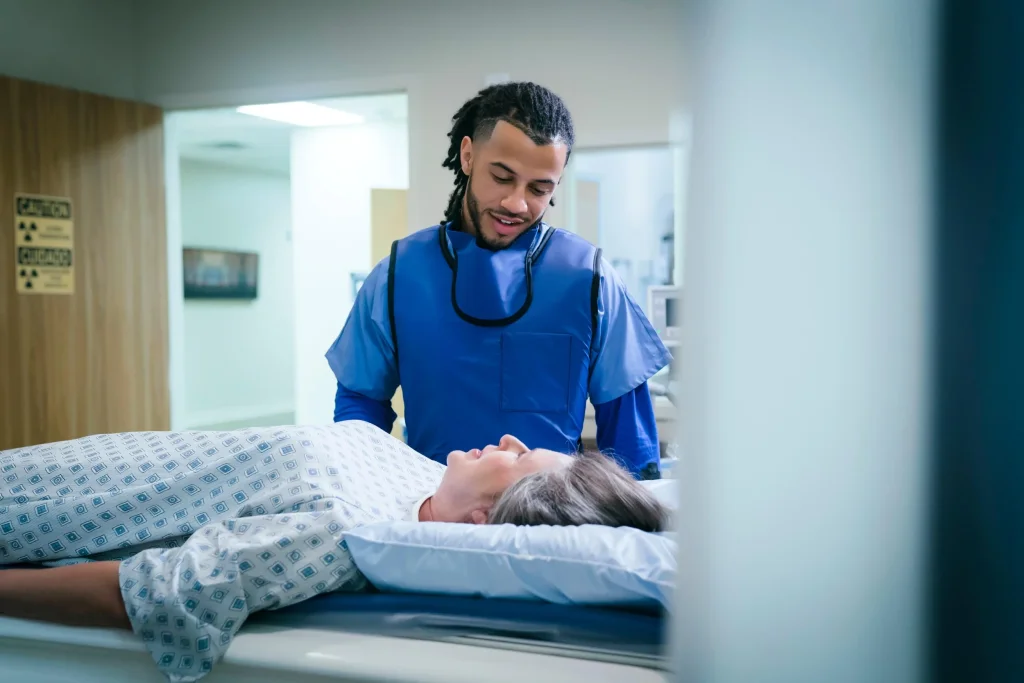
The Joint Commission (TJC) provides healthcare organizations with accreditation and helps them create an environment of zero harm by conducting onsite audits about every 36 months.
TJC requires healthcare facilities to inspect medical equipment annually, including lead aprons, and document the inspection findings.
Our customers report that during audits, TJC will often pick up a lead garment and ask for the latest inspection report for that specific garment. They also may request to view the X-ray garment inventory maintenance log. (We built RADCOMPLY to remove this headache and ensure you’re ready for any pending audits.)
TJC recommends having a system in place to evaluate X-ray garments. However, they do not specify what inspection methods should be used or the rejection criteria for medical equipment and aprons. Some of these specific requirements vary from state to state, so some clarity can be found by turning to individual state guidelines.
Regardless, it’s essential to choose the proper inspection method to ensure the safety of your staff and patients.
Note: RCS is committed to supporting healthcare networks in achieving successful Joint Commission audits. Although not directly audited ourselves, our in-depth knowledge of lead apron management and compliance best practices and extensive experience working alongside healthcare facilities have equipped us with invaluable insights into audit preparation.
Our Recommendation
After a decade of experience, we recommend performing radiographic scans once a year. The results prove to us that this is the best practice to keep staff and patients safe, regardless of state regulations.
You can also perform visual or palpation inspections, but relying on those inspection methods alone for lead apron safety is insufficient. Annual radiographic inspections are essential for identifying hidden damage.
Document the inspection history of each garment upon receiving newly purchased garments. Findings from all inspections should be thoroughly documented and easy to access when TJC (or State Boards) are onsite for audits. Documentation upon receiving the garment allows you to remain compliant from the start. We have an inspection checklist that’s free to download here.
If your team doesn’t have the time or resources to remain compliant, RCS can perform annual integrity checks for you and document them in our inventory management system.
Why Radiographic Inspections Are Essential
Physicians K. Lambert and T. McKeon performed a study to establish stringent rejection criteria for lead aprons. Their findings suggest aprons should be replaced when defects exceed:
- 15 mm² when over critical organs (thyroid and gonads).
- 670 mm² when along the seams, in overlapped areas, or on the back.
- 11 mm² for thyroid shields.
You are unlikely to notice an 11 mm² hole in your thyroid collar without a radiographic inspection (X-ray scan).
Additionally, a study on lead apron safety found that small defects in a garment’s integrity can progress rapidly, with an average tear increase of over 270% in 10 months. Our experience aligns with the study’s findings.
The Risk of Not X-ray Scanning Lead Garments
Improperly inspected X-ray protective garments can pose health risks and lead to legal and financial consequences.
A surgeon filed a lawsuit in 2017 against the hospital he worked at after developing thyroid cancer. Allegedly, improper radiation protection practices lead to his thyroid cancer diagnosis and the diagnoses of at least seven other hospital employees, including two fatal cases.
Why Regular Inspections Are Important
- Compliance: TJC requires proof of annual lead apron inspections.
- Reduce Costs: Keeping track of minor tears and repairs extends the lifespan of lead aprons, saving you money on recycling old aprons and ordering new ones.
- Staff & Patient Satisfaction: Regularly inspected aprons remain in better condition, which boosts staff and patient satisfaction because they’re more comfortable and feel safe in the garment.
How RCS Can Help
Yearly X-ray scans of your aprons can be tedious and time-consuming. We think it’s essential for staff safety, so we include it free of charge with our other services.
While building the inventory on behalf of the customer, RCS tags each garment with an asset tag, which has a facility name, department name, and garment description. The tag also has a QR code that immediately accesses the garment’s year-over-year X-ray scan history.
When TJC asks for the garment’s inspection history, all you have to do is pull out your phone and scan the QR code, and the auditor can review the stored X-ray image on file.
Our customers consistently receive “Best Practice” remarks from TJC during audits using the guidelines outlined in this article. Watch a testimonial.
Contact us today to learn more and schedule service.












